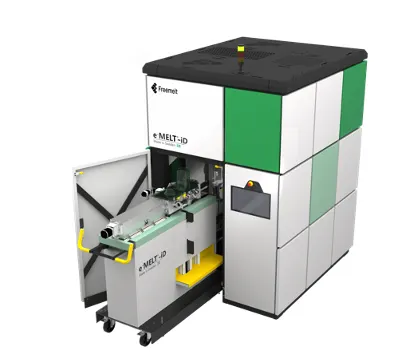UKAEA Acquires e¯MELT® System to Advance Fusion Component Manufacturing
By Karl Tischler

An e¯MELT® Electron Beam Powder Bed Fusion Additive Manufacturing machine (Courtesy of Freemelt AB)
The UK Atomic Energy Authority (UKAEA) has taken a significant step toward in-house development of fusion reactor components with the acquisition of an e¯MELT® additive manufacturing system from Swedish technology company Freemelt AB.
The machine, which uses Electron Beam Powder Bed Fusion (E-PBF) technology, was delivered to UKAEA in March 2025. While it has not yet been deployed, the move marks a shift from feasibility studies to hardware investment—positioning the UK to explore new approaches to manufacturing critical tungsten components for future fusion systems.
What is e¯MELT®, and why does it matter?
The e¯MELT® system—short for “efficient Melting”—was designed from the ground up for processing refractory metals like tungsten, which are central to fusion reactor designs. Freemelt’s system combines:
- A powder bed that reaches over 1200°C,
- A unique cooling system that maintains surrounding areas below 100°C,
- High-speed electron beam control that allows tailored material properties,
- A vacuum process that reduces oxygen content in printed parts by up to 90%.
These features enable the production of complex, high-performance tungsten components that are difficult or impossible to create using traditional or laser-based manufacturing.
“UKAEA’s investment in e¯MELT® is an important confirmation that our E-PBF technology meets the demanding requirements in fusion,” said Daniel Gidlund, CEO of Freemelt.
From feasibility to fabrication
UKAEA and Freemelt began collaborating in April 2023. Together, they carried out three feasibility studies:
- Developing basic process settings for fusion components
- Developing process settings for first wall components
- Assessing robustness and productivity of the manufacturing process
Following this work, UKAEA purchased an industrial e¯MELT® system—valued at approximately SEK 8 million—to bring production capability in-house.
Why tungsten, and why now?
Fusion devices like ITER, STEP, and DEMO require first-wall components that can withstand extreme heat, particle flux, and neutron bombardment. Tungsten is a leading candidate material, but its high density and brittleness make it difficult to shape, especially using conventional manufacturing.
Freemelt believes its E-PBF approach overcomes these barriers. The ability to reduce oxygen content, avoid cracking, and customise microstructures offers a breakthrough in fabricating durable tungsten tiles.
“The more we learn about tungsten, the more we realise the limitations of traditional manufacturing and laser-based 3D printing,” said Gidlund. “Our technology makes it possible to meet the expectations of the fusion industry.”
Demand for such components is vast. ITER alone is expected to require over 1 million tungsten tiles for its first wall. Even smaller machines under development by private fusion startups are estimated to need about 10% of that amount.
UKAEA's perspective: testing a novel approach
As UKAEA prepares to deploy the e¯MELT® system, its focus remains on ensuring that materials and manufacturing methods meet the extreme demands of future reactors.
“The components within future fusion power plants will need to withstand extreme conditions,” said Roy Marshall, Head of Operations for Fabrication, Installation and Maintenance at UKAEA.
“UKAEA is researching a range of solutions so fusion components, such as the first wall, can withstand these conditions and ensure that fusion power plants will be durable, reliable and commercially viable.
“One of these possibilities is using additive manufacturing to develop tungsten material and layering the tungsten with other materials. This is a novel application, not yet mastered by industry, and we look forward to trialling this approach at UKAEA’s Culham Campus as we receive the technology in the coming months.”
Strategic context and what comes next
The e¯MELT® delivery comes at a time of rising global investment in fusion. In 2024, total funding in the field exceeded USD 7.1 billion, with contributions from both public initiatives (e.g., STEP, ITER, DEMO) and private firms like Commonwealth Fusion Systems.
UKAEA has confirmed that a fuller announcement—including photos and technical updates—will be made once the system is operational. For now, the acquisition signals that advanced manufacturing is moving from exploration to execution in the race to commercial fusion.
Further reading:
- Freemelt press release: https://freemelt.com/mfn_news_en/freemelt-delivers-the-industrial-machine-emelt-to-ukaea/
- Metal AM Autumn 2024 (from pages 185 to 197): https://issuu.com/inovar-communications/docs/metal_am_autumn_2024
- Interesting Engineering article written by Aman Tripathi: UK fusion reactors to get super strong tungsten to beat extreme heat with eMELT device https://interestingengineering.com/energy/uk-fusion-reactors-to-get-strong-tungsten
